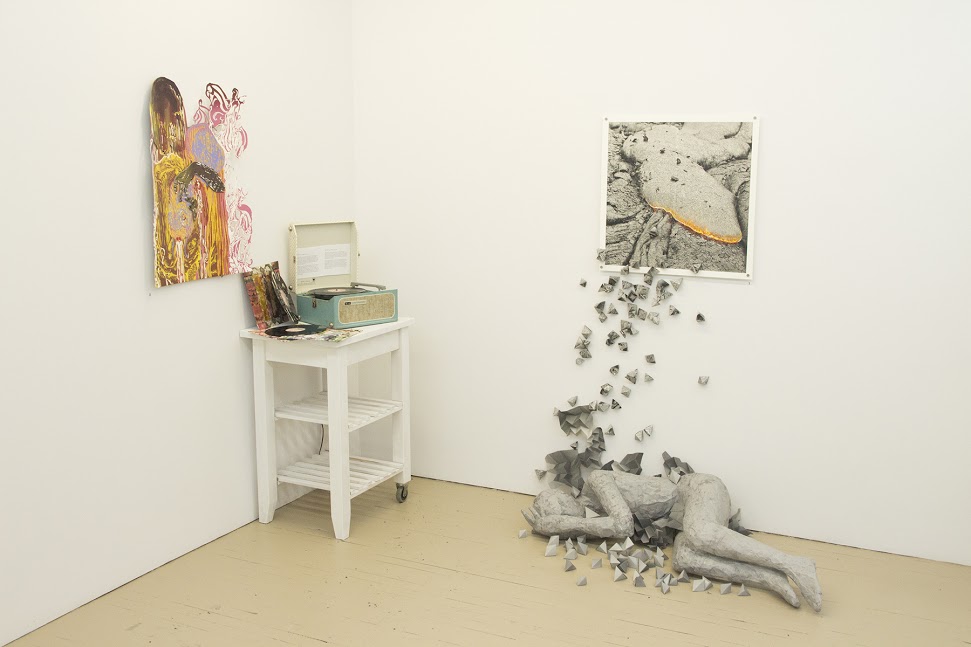Concordia’s print media students integrate woodcutting into their work
Anyone who disregards woodwork as a serious artform should reconsider their opinion—it is not solely for lumberjacks and carpenters.

Eager student artists from Concordia’s print media program—a program that teaches students subjects such as lithograhpy, screenprinting, digital printing and more—have integrated woodcutting techniques into their work in order to provide viewers with a multisensory, engaging exhibit of woodcut art. The space, located on the fourth floor of the Popop Gallery on Ste. Catherine St. W, is no larger than a one-bedroom apartment, but it is packed with multiple artworks, all showing diverse articulations of woodblock prints.
Off the Block features mesmerizing prints showing built-up layers of colours and engravings. The exhibit, organized entirely by Concordia’s student artists, boasts interactive pieces like a life-sized tent draped with linens printed with woodcut designs. Among these different creations, viewers learn how woodcut work is employed both in traditional and modernized ways.
Unlike some contemporary art productions, woodcut prints are laborious with unpredictable results.
“The colours are very difficult because I started with black and [proceeded until] I was at my lightest colour, which was yellow,” said Ben Salmon-Beitel, one of the 19 featured artists, as he pointed out the intricacies of his work East Coast Ruffnecks. He went on to say that applying the colours on the woodcut surface does not necessarily turn out exactly as planned and tiny mistakes often lead to starting over.
However, once the final product is complete, the long process is typically well worth it. Print media student and artist Nikki Kuentzle’s Engulfed in Flames piece is based off a simple bronze screen print inspired by a collection of David Sedaris essays. “I [decided] to make this work three-dimensional … and I went into more detail with the shingles and the lines on the actual house; I think it turned out better than the screen print,” said Kuentzle.
Artist Hannah Materne’s Sealf adheres woodcut prints that resemble crustaceans and barnacles to hand-collected rocks. “All the barnacles [attached] to the rocks are … abstractions of things that I use to take care of myself,” said Materne as she pointed to her favourite nail polishes, plates and socks plastered onto the rocks’ surfaces.

To achieve a variety of colours and textures in their works, most students employed reduction, which Elizabeth Xu described as a “really intense technique” that took eight weeks to complete for her piece titled Gullin With My Father. The process involves creating a multi-coloured print using one woodblock. To obtain more than one colour in a print, the woodblock surface must be continually carved between each printing. As more pigments are added to the block, the colours begin to build upon themselves, producing a multi-coloured print.
The woodwork possibilities do not end there and once a woodcut block has been carved or printed onto paper, it can still be manipulated onto any type of canvas, traditional or otherwise.
Furthermore, Off the Block physically encourages viewers to step into a woodcut world—Xu’s second work, Moonsun, showcases a woodblock print that was burnt into silkscreen. The print was then applied to this fabric and fashioned into a tent structure that people could stand in.
Madeleine Gendreau’s Dro PP T ca: Lathe L aa t tte invited viewers to manipulate the records made with woodcut prints, while Michael Maclean’s Smoke’n Lines Chair challenged the traditional canvas by applying a laser woodcut textile onto the upholstery of a chair.
Modern technology is still shaping this type of production. “[Today] laser cutters [are used to carve the wood] and they are the latest technique out there,” said print media professor Bonnie Baxter, and Xu said new technological advancements deliver very “photographic results,” such as Abbie Rappaport’s PRESS START digital and woodblock print, which looks like it came from a camera rather than wood.
“They got it together … they didn’t have any grants [and] they found the place themselves,” said Baxter. While the professor was a supporter in organizing the exhibit and the idea was decided on somewhat late, the works are a clear indication of a determined group focused on redefining what woodcut printing can produce. The group fully committed themselves to the work both in the printing studio and in planning event details.
In doing so, the class has widened the interpretation of the woodwork used in print media; this often unpredictable medium is shown in traditional and modern ways. The wood acts as a matrix, through which the artistic possibilities are endless.
Off the Block is open from Jan. 13 to Jan. 25, Tuesday through Sunday from noon to 7 p.m. at Popop Gallery (372 Ste. Catherine St. W).



